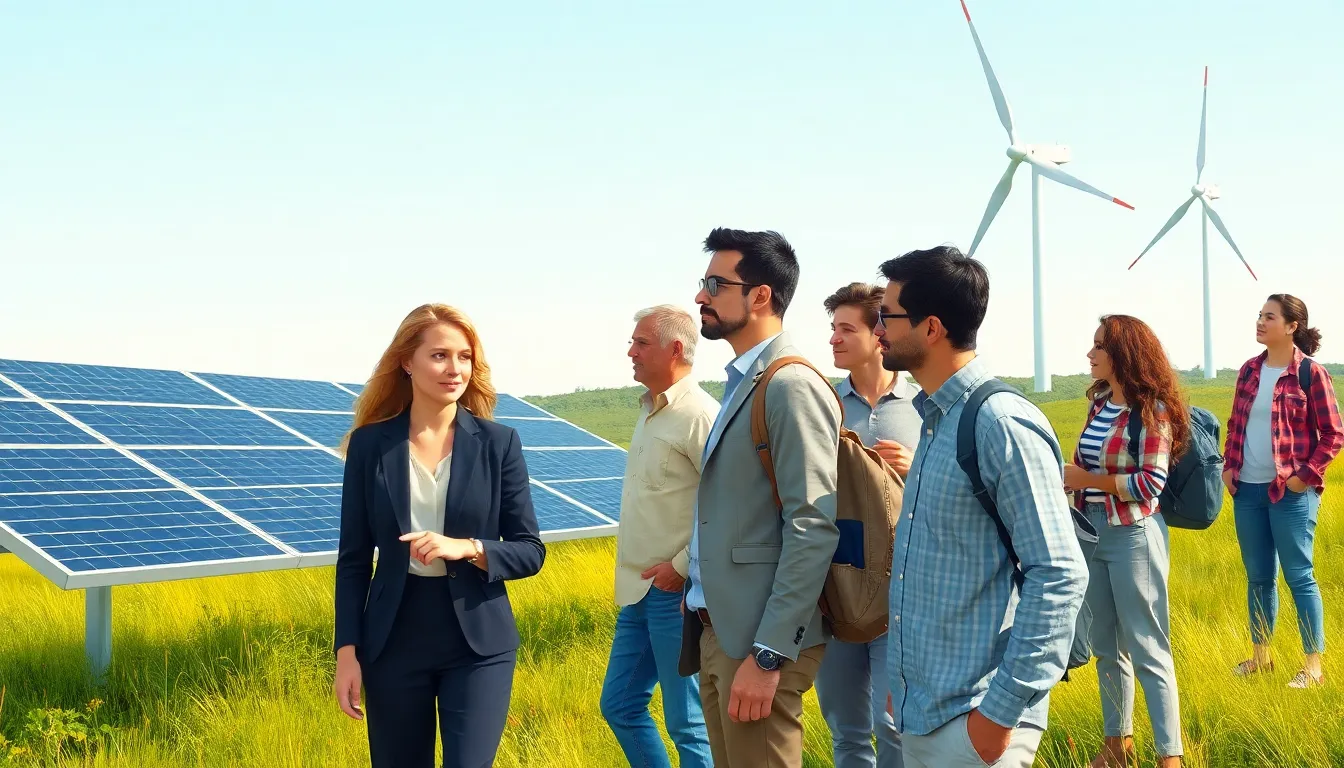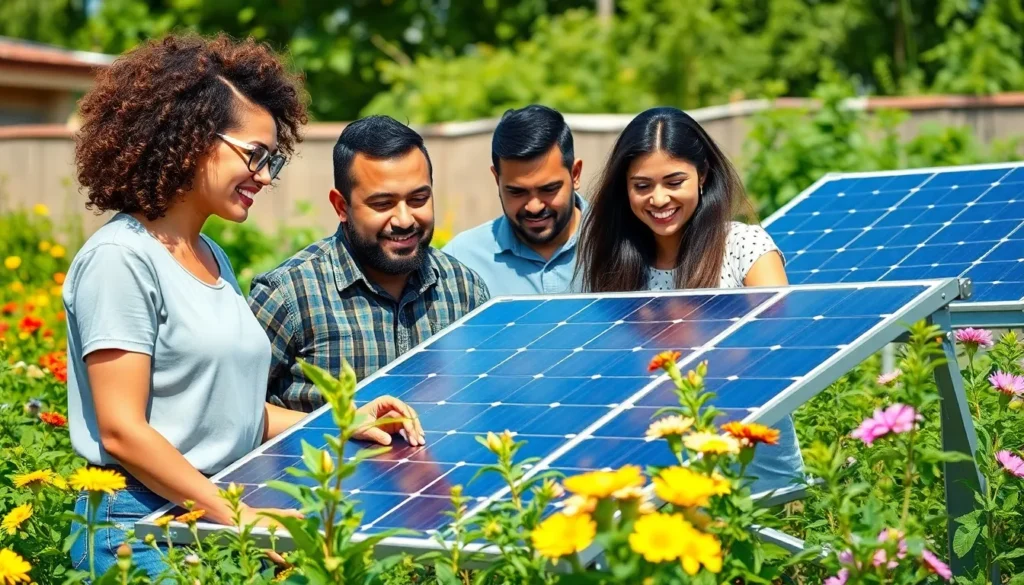Table of Contents
ToggleImagine a world where technology doesn’t just make life easier but also helps save the planet. Welcome to the realm of sustainable technology, where innovation meets environmental responsibility. It’s like having your cake and eating it too—only this cake is made from recycled ingredients and tastes even better!
What Is Sustainable Technology?
Sustainable technology refers to innovations that minimize environmental impact while meeting present needs. This field encompasses a range of approaches including renewable energy sources, eco-friendly manufacturing processes, and sustainable materials. It aims to reduce waste, conserve energy, and promote resource efficiency.
One example of sustainable technology is solar panels, which convert sunlight into electricity. These systems reduce dependency on fossil fuels and decrease greenhouse gas emissions. Wind turbines serve a similar purpose by harnessing wind energy, providing a clean alternative for electricity generation.
Green building practices offer another aspect of sustainable technology. Such practices prioritize energy efficiency, water conservation, and sustainable materials in the construction process. Building designs may include features like green roofs, which enhance insulation and promote biodiversity.
Transportation technologies also play a crucial role. Electric vehicles (EVs) produce zero tailpipe emissions and can utilize renewable energy sources for charging. Additionally, biofuels derived from organic materials present another cleaner alternative for conventional fuels.
Various innovative technologies also focus on waste management. Recycling systems convert materials back into useful products, minimizing landfill impact. Composting technologies break down organic waste, enriching soil and reducing methane emissions from landfills.
Sustainable agriculture represents another vital area. Techniques like precision farming utilize data-driven approaches to optimize resource use, minimizing water and fertilizer application while maximizing yields. Vertical farming increases space efficiency and reduces transportation emissions by growing food closer to urban centers.
Overall, sustainable technology integrates environmental stewardship with human advancement. This integration emphasizes the importance of balancing modern conveniences with the health of the planet.
Key Principles of Sustainable Technology


Sustainable technology incorporates principles that focus on environmental preservation, economic stability, and social equity. Each principle is vital for truly promoting a sustainable future.
Environmental Impact
Minimizing environmental impact stands at the forefront of sustainable technology. Renewable energy sources such as solar panels and wind turbines generate power without harmful emissions. Eco-friendly manufacturing processes utilize sustainable materials, reducing waste and resource depletion. Additionally, technologies that promote efficient waste management, like composting and recycling, lower landfill contributions. Experts agree that sustainable technology fosters a circular economy, where resources are reused and repurposed, contributing to a healthier planet.
Economic Viability
Economic viability ensures that sustainable technologies not only address environmental concerns but also support financial stability. Innovations must offer cost-effective solutions, allowing businesses and consumers to adopt them without significant financial strain. Renewable energy technologies often result in lower long-term energy costs. Investments in sustainable practices can create green jobs and stimulate economic growth. Research shows that companies implementing sustainable technologies can enjoy enhanced competitiveness and brand loyalty, leading to increased profitability.
Social Responsibility
Social responsibility emphasizes the ethical dimensions of sustainable technology. Technologies that prioritize equitable access foster inclusive growth and opportunity. Responsible innovation considers the needs of vulnerable communities, ensuring they benefit from advancements. Furthermore, sustainable practices in agriculture can lead to food security and improved public health outcomes. Initiatives that engage local stakeholders and promote community participation strengthen social ties while driving sustainability. Compliance with ethical standards promotes transparency, fostering trust between businesses and communities.
Examples of Sustainable Technology
Numerous innovations illustrate sustainable technology’s impact, reflecting its commitment to environmental stewardship and efficiency.
Renewable Energy Sources
Renewable energy sources lead the charge in sustainable technology. Solar panels harness sunlight, turning it into clean electricity, while wind turbines convert wind energy into power. Both methods significantly reduce dependence on fossil fuels, lowering greenhouse gas emissions. Geothermal energy taps into the Earth’s heat, offering a reliable, sustainable power source. Hydropower, utilizing flowing water, generates electricity with minimal environmental impact. Each option represents a crucial step toward a greener energy future.
Smart Agriculture
Smart agriculture employs technology for sustainable farming practices. Precision farming, enabled by sensors and data analytics, optimizes resources such as water and fertilizers. Drones monitor crop health, identifying issues early for timely interventions. Vertical farming offers innovative solutions, allowing crops to grow indoors in stacked layers, conserving land and water. Organic farming principles enhance soil health, promoting biodiversity. Together, these methods reduce environmental footprints while increasing food production.
Green Building Practices
Green building practices prioritize sustainability in construction and design. Energy-efficient designs ensure lower energy consumption, often integrating renewable energy sources. Sustainable materials, such as recycled steel or sustainably sourced wood, minimize environmental impact. Smart technologies, like automated systems for lighting and heating, further enhance efficiencies. LEED certification tracks sustainable performance, ensuring buildings meet rigorous standards. Additionally, green roofs and walls provide insulation and promote biodiversity, making buildings eco-friendly.
Benefits of Sustainable Technology
Sustainable technology offers numerous benefits that impact both the environment and society positively.
Reducing Carbon Footprint
Sustainable technology significantly reduces carbon emissions. Innovations like solar panels and wind turbines harness renewable energy, cutting reliance on fossil fuels. Electric vehicles contribute further by providing cleaner alternatives to traditional combustion engines. Implementing energy-efficient systems in homes and buildings minimizes energy consumption, directly lowering greenhouse gas outputs. Many companies are adopting sustainable production methods, which also lower their carbon footprints. By prioritizing these practices, individuals and organizations actively participate in the fight against climate change.
Promoting Resource Efficiency
Resource efficiency stands at the forefront of sustainable technology. Utilizing renewable materials in manufacturing processes conserves non-renewable resources, reducing waste. Innovations encourage circular economy practices, where materials are reused and recycled rather than discarded. Smart agricultural techniques optimize water and energy use, leading to reduced environmental stress. Many green technologies, such as smart meters, help monitor and manage energy consumption more effectively. Through these advancements, sustainable technology promotes a more efficient use of natural resources, ensuring their availability for future generations.
Enhancing Quality of Life
Quality of life improves significantly through sustainable technology. Clean energy solutions lead to healthier living environments by reducing air pollution. Access to efficient transportation options encourages community connectivity and decreases commute times. Smart home technologies, aimed at energy conservation, allow individuals to reduce their monthly utility bills while enhancing comfort. Sustainable practices in agriculture ensure food security and promote healthier options. By fostering economic growth through green jobs, sustainable technology elevates overall living standards, creating a more sustainable and equitable society.
Sustainable technology represents a pivotal shift toward a future where innovation aligns with environmental responsibility. By integrating renewable energy, eco-friendly practices, and efficient resource management, it offers a pathway to reduce carbon footprints and enhance quality of life. The commitment to sustainability not only addresses current challenges but also ensures that future generations inherit a healthier planet. Embracing these technologies fosters a culture of stewardship that benefits society as a whole, creating jobs and promoting equitable access. As sustainable technology continues to evolve, it holds the promise of a balanced coexistence between human advancement and environmental health.







